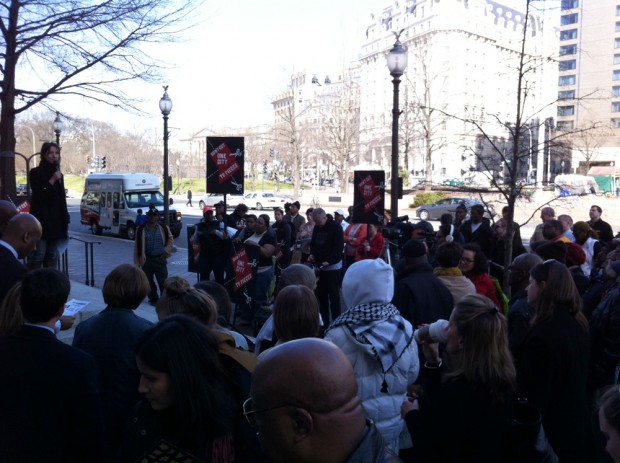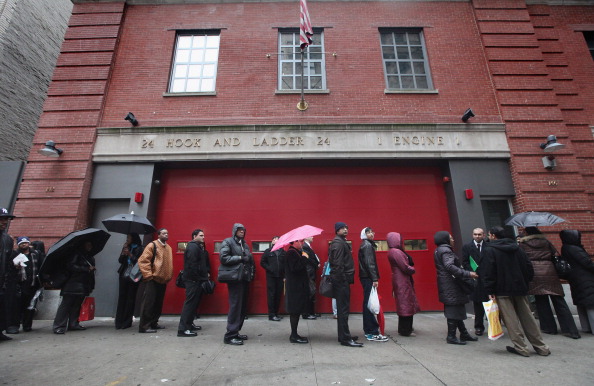Nearly a quarter of total D.C. households are considered “underbanked.” Those families have bank accounts but still regularly use things like check cashers or payday lenders, which can make the cost of accessing money expensive. And many underbanked households in D.C. are black, Hispanic or making less than $30,000 a year.
Turns out that banking from phones could be a way to increase access to financial services. Results from a new Federal Reserve Board survey show that mobile banking is more prevalent among traditionally underbanked groups. For instance, black and Hispanic mobile phone users are much more likely to use mobile banking than their white counterparts, according to the survey.
Mobile phones have also been suggested as a solution to reducing the digital divide that persists in the District. Blacks and Hispanics are already making greater use of mobile broadband than whites.
The widespread use of mobile technology has the potential to expand access to financial services for previously underserved populations. Underbanked individuals (people with bank accounts but who use check cashers, payday lenders, or payroll cards) make relatively heavy use of mobile banking, according to the survey. Of this group, 29 percent used mobile banking in the year ending in January 2012.
Read more at: www.federalreserve.gov
A punk rock show poster depicting a cartoon Native American, seemingly intoxicated and with fangs, inspired Washington City Paper’s Jonathan L. Fischer to ask, well, is it racist? The poster is for Windian Records‘ third anniversary, and label owner Travis Jackson defends the poster, partially saying it’s consistent with the style of the artist who designed the poster.
But more interestingly, Jackson says he’s one-fourth Cherokee and adds that “white Indian” is one of his nickname, which inspired his record label’s name. “I’m Native and I’m not offended,” he tweeted, “How are you?” What do you think of the poster?
Does it make a difference that Jackson is one-fourth Cherokee and identifies as Native American? Read more of his poster artist Ben Lyon’s thoughts below, as emailed to Fischer:

“Anyway…I know I’m not a racist. I think anyone offended enough to make a big stink over the art on a poster for a punk show, that they probably aren’t gonna attend in the first place, probably needs to get a life. Leave it to white American 20-somethings to see a neo-nazi lurking behind every tree.(ha ha!) Who says Indians can only be drawn as stern wisemen? Sounds like stereotyping to me!(ha ha) I would have no problem showing the poster to any of my Native American friends. I stand by my work.”
Read more at: www.washingtoncitypaper.com
D.C.’s unemployment rate dropped to 9.9 percent in January, down from 10.1 percent the month before, according to preliminary data released today by the U.S. Bureau of Labor Statistics. January’s national unemployment rate was 8.3 percent.
The District’s unemployment rate remained above 10 percent throughout 2011, so the slight dip is good news. But D.C. actually lost 11,500 jobs in January. DCist reports on how the city’s unemployment rate could have dropped despite the declining number of jobs:

One reason the District’s jobless rate fell while even though the number of jobs decreased as well might be the number of D.C. residents who are finding work in the suburbs, said David Cooper, an expert in state labor trends with the nonpartisan Economic Policy Institute.
“For the District in particular we’re seeing people move into the District but taking jobs in Virginia and Maryland,” Cooper said in an interview. “Certainly the unemployment rate going down is good news. People finding jobs is good news, whether in the District, Maryland or Virginia.”
Read more at: dcist.com

Elahe Izadi / DCentric
D.C. Fair Budget Coalition's Janelle Treibitz pushes for protecting social service funding during a Monday rally.
Sandra Williams, 58, takes classes at a D.C. nonprofit in pursuance of a GED certificate. She eventually wants to become a social worker, but she’s unemployed for now and said she has can’t get a job because of her poor credit.
Anthony Hunter, 27, recently became homeless. The single father said that he needs a little help to get back on his feet. He currently lives off of $623 a month, he said.
Karima Weathers, 39, a single mother raising three children, recently lost her eyesight. She’s been in and out of shelters and has spent winter nights in her car.
They all turned out to a rally on the Wilson Building’s steps Monday morning, calling for Mayor Vincent Gray to spare funding cuts to social service programs and initiatives that help low-income D.C. residents. The rally was organized by the advocacy group D.C. Fair Budget Coalition. Mayor Gray is expected to release his proposed budget March 23.
Advocates say the situation is dire; one in three D.C. children lives in poverty and the waiting list for affordable housing is more than 37,000 people long. Continue reading →
A common heart disease drug may have a surprising side effect: reducing subconscious racism. A study led by an Oxford University doctor and published in the journal Psychopharmacology found that people who took propranolol were less likely to show implicit racist attitudes than people took a placebo. The drug didn’t have any effect on explicitly racist attitudes.
The sample size of the study was small, and some scientists caution against drawing broad conclusions. But others say the findings raise interesting questions as to whether racist attitudes could be altered with drugs, “a possibility that requires careful ethical analysis,” the Australian Associated Press reports.

Scientists believe the discovery can be explained by the fact that racism is fundamentally founded on fear.
Propranolol acts both on nerve circuits that govern automatic functions such as heart rate, and the part of the brain involved in fear and emotional responses. The drug is also used to treat anxiety and panic.
Read more at: www.adelaidenow.com.au
A reader adds to our discussion on whether poor children benefit by having rich neighbors. Soulshadow55 writes:
Yeah, that’s all well and good but what usually happens is that the neighborhood improves to the point that poor families can no longer afford to live in it. The increased tax base continues to attract so-called wealthy people to the neighborhood which decreases the number of poorer families with children. The new so-called wealthy people benefit more from all of the new facilities, the playgrounds, improved schools, better services, etc… [SIC]

Harold Neal / Flickr
Gentrification is one of the main reasons behind why more poor District children now live in wealthier neighborhoods. Such neighborhood revitalization, which brings along amenities that children can benefit from, also increases property values. As a result, low- and moderate-income families renting at market rates may get priced out.
Those living in public housing, however, could be somewhat buffered by the negative impact of rapid gentrification, since rents remain steady. Take Columbia Heights, where public housing apartments are on the same block as million dollar homes. But good luck to anyone seeking public housing — the waiting for affordable housing vouchers in the District has swelled to more than 37,000-people long.
Take a look at this graphic by the blog R. U. Seriousing Me? mapping out which District neighborhood has the highest percentage of native Washingtonians. Nearly 84 percent of Barry Farm residents were born in D.C. Meanwhile, only about 38 percent of people living throughout the city are native Washingtonians.

Two weeks ago, a Ward 8 resident told me she supports Marion Barry for re-election because he is a Native Washingtonian. He is not. But anyone familiar with local politics in the District of Columbia knows the cachet that accompanies Native Washingtonian status.
Read more at: ruseriousingme.blogspot.com
Famed photographer Gordon Parks, whose works include “American Gothic,” died six years ago this week. Parks spent considerable time in D.C. in the 1940s while under a Farm Security Administration fellowship. Take a look at the photo gallery put together by Huffington Post DC that showcases Parks’ works depicting daily life in the District more than 70 years ago.

From this experience, Parks would continue on to produce his most famous work, “American Gothic, Washington, D.C.,” depicting a cleaning woman by the name of Ella Watson. Holding a broom and mop in front of a large American flag, the photo, Parks’ mentor called the powerful photo “an indictment of America.”
“I realized from the reaction of people that the camera could be a very powerful instrument against discrimination, against poverty, against racism,” Parks said of his work.
Read more at: www.huffingtonpost.com
The rich are richer in D.C. than in other large cities, but the District isn’t teeming with billionaires, either. Out 1,226 billionaires around the world, only one calls D.C. his home: Steven Rales, co-founder of manufacturing company Danaher. With a net worth of $3.3 billion, Rales comes in at number 344 on Forbes’ annual list of billionaires.

Co-founder of manufacturing and technology company Danaher, Steven Rales, along with brother Mitchell, left his father’s real estate firm in 1979 and started buying small manufacturing companies during the junk bond frenzy of the 1980s. The result was Equity Group Holdings, co-founded with his billionaire brother. The brothers acquired a crippled REIT, and fused it with other industrial companies to form Danaher, named after the Montana stream where they once fished for trout. They took the industrial pump maker Colfax public in 2008. In January, Colfax finalized a $2.4 billion deal to buy British welding, cutting and automation company Charter International. Steven is now chairman of the board of Danaher. He is reportedly a dedicated supporter of the Washington Ballet and DePauw University. He also founded a film production company in Santa Monica, Calif., Indian Paintbrush, which produced Wes Anderson’s “The Darjeeling Limited”, “Fantastic Mr. Fox” and the upcoming “Moonrise Kingdom.”
Read more at: www.forbes.com

Mario Tama / Getty Images
Job seekers wait in line to attend a job fair in New York City on Jan. 26.
The national unemployment rate remains unchanged at 8.3 percent, but unemployment dropped slightly for whites while it rose for African Americans and Hispanics, according to data released Friday morning by the U.S. Bureau of Labor Statistics.
Unemployment among whites dropped from 7.4 percent in January to 7.3 percent in February. For blacks, it rose from 13.6 to 14.1 percent. The Hispanic unemployment also slightly rose, from 10.5 to 10.7 percent. The bureau doesn’t have seasonally-adjusted unemployment data for Asians. Unemployment among immigrants rose from 9.7 to 10 percent while it dropped for U.S.-born citizens, from 8.2 to 7.8 percent.
Although overall unemployment didn’t change between January and February, the economy did see the addition of 227,000 new jobs. Unemployment didn’t drop largely because more people entered or returned to the labor market after giving up looking for work. The rate measures how many people in the labor market don’t have jobs.
Data on local unemployment rates, including D.C., will be released Tuesday. The latest unemployment figure for D.C. is 10.1 percent, higher than the national average.











